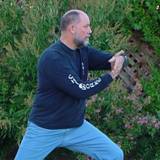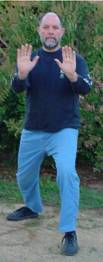Moves, Movements, and Forms
At the core of Tai Chi practice is learning a form, which is a prescribed sequence of movements. Each movement is apt to be made up of a sequence of individual moves. Think of a form as an essay, a movement as a paragraph, and a move as a sentence.A movement can also be called a pattern, and a move can also be called a technique. To add to the confusion, either may be called a posture or gate.
According to what I have been told, I am learning "the first section of
authentic Yang Tai Chi Chuan long form." Yang is the name of the Chinese family that created this partiuclar style of Tai Chi.
So my memory has been at fault, for I thought I was learning a Yang short form. The difference between a long form and a short form is the number of movements. In Yang long form there are up to 108 movements. Many of them are repeated here and there during the form, so a short form emerges when repeated movements are excised. But in a short form, other, non-repeated movements may be dropped also. The remaining movements my be reordered as well.
Possibly with the exception of transitional moves between movements to keep the form flowing, the movements/patterns themselves — and the moves/techniques of which they are made — don't change within any particular style of Tai Chi.
How does all this affect me? It has to do with the fact that I haven't been able to remember the first movements I have been taught, to practice them at home.
So I thought books might help. Only problem was, the first books I bought — to the extent they were Yang-style books — did Yang short form (YSF). The opening movements aren't the same as in Yang long form (YLF). Nor was it easy for me to find the YSL opening movements buried elsewhere within YSF.
That's when I became aware that my course syllabus said "the first section of authentic Yang Tai Chi Chuan long form" — not YSF!
So, back to the bookstore.
 There I found The Dao of Taijiquan: Way to Rejuvenation, by Jou (family name) Tsung Hwa, a book recommended by my instructor, Brad, that I had thought out of print.
There I found The Dao of Taijiquan: Way to Rejuvenation, by Jou (family name) Tsung Hwa, a book recommended by my instructor, Brad, that I had thought out of print.This is a book dense with information, with little eye appeal. There are lists of movements in the forms, accompanied by profuse illustrations of each form (including Yang's Long Taijiquan starting on p. 64). But the illustrations are tiny black-and-white drawings that are fuzzy due (I imagine) to multi-generational reproduction. So they are hard to follow.
Before proceeding further, I ought to admit that I'm something of a cretin when it comes to "spatial" intelligence. Tai Chi involves complex moves in three-dimensional space, and when I see the moves rendered two-dimensionally on the printed page, my brain wants to cop out. I don't "read" these illustrations all that well in the first place.
Still, there was enough information given that I was able to recognize the third move in the Yang Long Taijiquan list as one of the initial moves I had been taught. Its name in the book, Ward-Off Right, corresponded to the name Brad had given: Ward Off. And the entire series of illustrations did look familiar.
So I forced myself to slow down and look very very hard at the diagrams, and to think about what I was looking at — certainly, one of the proverbial Tai Chi mindsets, anyway.
What I was seeing was, first of all, that (but see the end of this post) Brad is not using the same way to get to Ward-Off Right in the form. The book lists "1. Beginning of Taiji" and "2. Ward-Off Left" as leading to "3. Ward-Off Right." Brad instead uses a different (quicker?) transition to get to the posture called "Holding the Chi Ball" which begins Ward-Off Left.
But from there it looks as if what we have been taught corresponds to what the book says. (But see the end of this post for an update.)
Specifically, the book puts Ward-Off Left in this sequence:
- 2. Ward-off Left
- 3. Ward-off Right
- 4. Roll-back
- 5. Press
- 6. Push
It then says that this list of moves comprises the movement or pattern "Grasp Swallow's Tail."
Aha! I said.
Maybe, I said — and I was whispering right out loud to myself, right there in the bookstore, my concentration being so intense; and I'm sure the other customers thought me loony — maybe we are being taught "Grasp Swallow's Tail," or some variation thereof.
So now my problem (I whispered to myself) is to find a book that describes  and illustrates the "Grasp Swallow's Tail" pattern more accessibly. That book turned out to be The Complete Book of Tai Chi Chuan, by Wong Kiew Kit.
and illustrates the "Grasp Swallow's Tail" pattern more accessibly. That book turned out to be The Complete Book of Tai Chi Chuan, by Wong Kiew Kit.
This book also has small line drawings illustrating the moves, but this time they're clear and easy to pick up on. There's also a clearly written text description of "Grasping Swallow's Tail" on page 76.
The book's main drawback is that it doesn't document Yang long form ... only a shortened, 70-movement form in the Yang style.
Still, I figure it probably can clue me in on how to do all (or most) of the YLF movements, so that by cross-referencing it with the Jou book, I can get what I need.
But there are yet more complications. For instance, Grasping Sparrow's Tail is a pattern of movement composed of several subsidiary moves or techniques. Each of the latter has a name in English and a name in Chinese.
The first is Warding Off — I'm using Wong's wording now. Jou calls it Ward-off Right (as in this case) and Ward-off Left (its mirror image). The Chinese name according to Wong is peng.
Jou uses different Chinese names for Ward-off Left and Ward-off Right. I imagine they refer to the specific move to one side or the other, while peng refers to the general shape of the move.
A difference between the Wong and Jou books is that in the latter, Grasping Swallow's Tail seems to involve both Ward-off Left and Ward-off Right, while Wong seems to think it involves either, depending on which direction you do it in.
After Warding Off in the proper direction — or in the final dierction — we do Roll-Back, the technique called (in Chinese) lu by Wong and luo by Jou.
Next comes Press or Pressing, qi or ji.
Then, it's Push or Push Out, an in both texts.
And that's all you have to do to Grasp the Swallow's Tail!
When Grasp Swallow's Tail is done to the left, it is called zuolan quewei, as I learn from this Forum post. Done to the right, it is youlan quewei. Meanwhile, Jou calls Ward-off Left zuobing and Ward-off Right youbing. So I'm guessing that zuo means "left" and you means "right," and that bing and peng are the same: "ward off."
So here, from this web page, is a Grasp Swallow's Tail Left or zuolan quewei:
 2. Ward Off Left |  4. Roll Back |
 5. Press |  6. Push |
Update to the above: Attending another session of the class, I learned that the opening sequence we are being taught is just like that in the Jou Book ... with the exception that Jou's first movement, "1. Beginning of Taiji," has been replaced with "Embrace the Heavens" followed by entering a "Standing Tai Chi Meditation" posture.
In "Embrace the Heavens" we step forward with the left foot, putting no weight initially on the heel. As we do, we begin circling our arms to the sides and bringing the hands up somewhere around the height of our heads. As the hands come up and over toward the center line of the body, we shift weight forward fully onto the left foot. Then, as the circling hands start down the center line of the body, we bring our right foot forward and move it out to the right, toe down, no weight on it yet. As the hands, palms down, get to below waist level, we shift weight smoothly toward the right foot. We are in a slight crouch. Once the weight is centered, we come out of the crouch as we raise the hands to waist level, palms down, fingers relaxed. This is the "Standing Tai Chi Meditation" posture. From there we go into "2. Ward-off Left" and the rest of Grasping Swallow's Tail.











0 Comments:
Post a Comment
<< Home